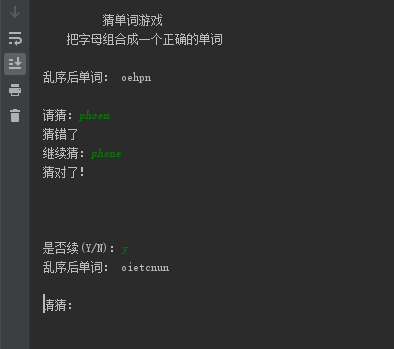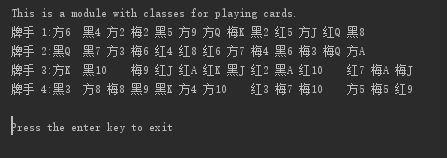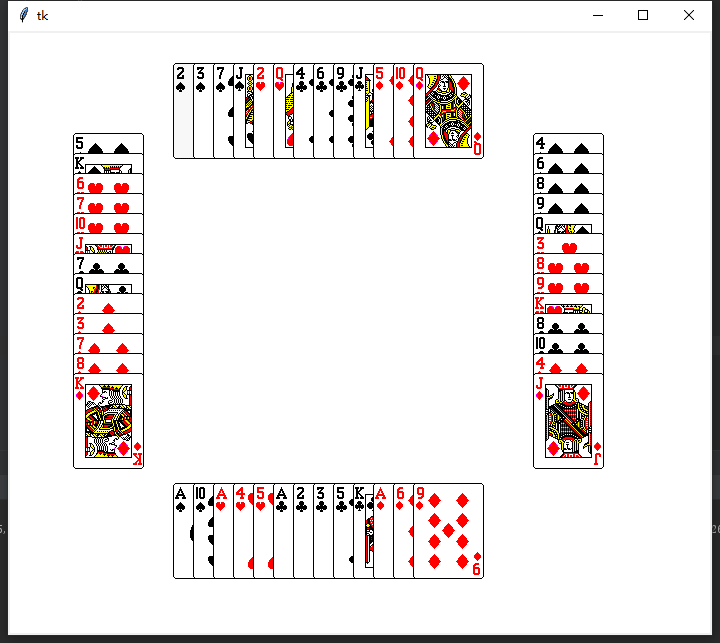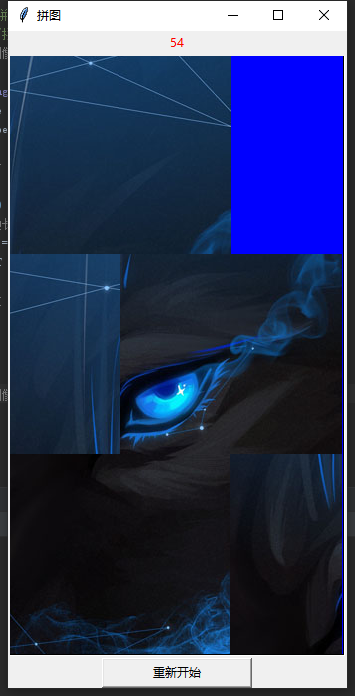2D游戏开发课程实验报告
本篇为验证性作业,代码为老师所给。
1.序列应用——猜单词游戏
功能介绍
猜单词游戏就是计筧机随机产生一个单词,打乱字母顺序,供玩家去猜测。此游戏采用控制字符界面。
代码:
import random
# 创建单词序列
WORDS = ("python", "jumble", "difficult", "answer", "continue", "phone",
"position", "game")
# start the game
print("""
猜单词游戏
把字母组合成一个正确的单词
""")
iscontinue = "y"
while iscontinue == "y" or iscontinue == "Y":
# 从序列中随机挑一个单词
word = random.choice(WORDS)
# 一个用于判断玩家是否猜对的变量
correct = word
# 创建乱序后单词
jumble = ""
while word: # word不是空串时循环
# 根据word长度,产生word的随机位置
position = random.randrange(len(word))
# 将position位置字母组合到乱序后单词
jumble += word[position]
# 通过切片,将position位置字母从原单词中删除
word = word[:position] + word[(position + 1):]
print("乱序后单词:", jumble)
guess = input("\n请猜:")
while guess != correct and guess != "":
print("猜错了")
guess = input("继续猜:")
if guess == correct:
print("猜对了!\n")
iscontinue = input("\n\n是否续(Y/N):")
运行结果

2.面向对象设计应用——发牌游戏
功能介绍
四名牌手打牌,电脑随机將52张牌(不合大、小王)发给四名牌手,并在屏幕上显示每位牌手的牌。
代码
# Card Module
# Basic classes for a game with playing cards
class Card():
"""" A playing card """
# 牌面数字 1--13
RANKS = ["A", "2", "3", "4", "5", "6", "7", "8", "9", "10", "J", "Q", "K"]
# 梅为梅花,方为方块,红为红心,黑为黑桃
SUITS = ["梅", "方", "红", "黑"]
def __init__(self, rank, suit, face_up=True):
self.rank = rank # 指的是牌面数字 1--13
self.suit = suit # suit指的是花色
self.is_face_up = face_up # 是否显示牌正面,True为正面,False为牌背面
def __str__(self): # print()
if self.is_face_up:
rep = self.suit + self.rank #+" " str(self.pic_order())
else:
rep = "XX"
return rep
def filp(self): #翻牌方法
self.is_face_up = not self.is_face_up
def pic_order(self): #牌的顺序号
if self.rank == "A":
FaceNum = 1
elif self.rank == "J":
FaceNum = 11
elif self.rank == "Q":
FaceNum = 12
elif self.rank == "K":
FaceNum = 13
else:
FaceNum = int(self.rank)
if self.suit == "梅":
Suit = 1
elif self.suit == "方":
Suit = 2
elif self.suit == "红":
Suit = 3
else:
Suit = 4
return (Suit - 1) * 13 + FaceNum
class Hand():
"""" A hand of playing cards """
def __init__(self):
self.cards = []
def __str__(self):
if self.cards:
rep = ""
for card in self.cards:
rep += str(card) + "\t"
else:
rep = "无牌"
return rep
def clear(self):
self.cards = []
def add(self, card):
self.cards.append(card)
def give(self, card, other_hand):
self.cards.remove(card)
other_hand.add(card)
class Poke(Hand):
"""" A deck of playing cards """
def populate(self): # 生成一副牌
for suit in Card.SUITS:
for rank in Card.RANKS:
self.add(Card(rank, suit))
def shuffle(self): # 洗牌
import random
random.shuffle(self.cards) # 打乱牌的顺序
def deal(self, hands, per_hand=13): # 发牌,发给玩家,每人默认13张牌
for rounds in range(per_hand):
for hand in hands:
top_card = self.cards[0]
self.cards.remove(top_card)
hand.add(top_card)
if __name__ == "__main__":
print("This is a module with classes for playing cards.")
# 四个玩家
players = [Hand(), Hand(), Hand(), Hand()]
poke1 = Poke()
poke1.populate() # 生成一副牌
poke1.shuffle() # 洗牌
poke1.deal(players, 13) # 发给玩家每人13张牌
# 显示4位牌手的牌
n = 1
for hand in players:
print("牌手", n, end=":")
print(hand)
n = n + 1
input("\nPress the enter key to exit")
运行结果

3.图形界面设计——猜数字游戏
功能介绍
在游戏中,程序随机生成1024以内的数字,再让玩家去猜,如果猜的数字过大过小都会进行提示,程序还会统计玩家猜的次数。使用Tkinter开发猜数字游戏
代码
import tkinter as tk
import sys
import random
import re
number = random.randint(0, 1024)
running = True
num = 0
nmaxn = 1024
nminn = 0
def eBtnClose(event):
root.destroy()
def labelqval(vText):
label_val_q.config(label_val_q, text=vText)
def numGuess():
if num == 1:
labelqval('我靠!一次答对')
elif num < 10:
labelqval('=_=十次以内就答对了牛....尝试次数:' + str(num))
elif num < 50:
labelqval('还行哦尝试次数:' + str(num))
else:
labelqval('好吧.....您都试了超过50次了.....尝试次数:' + str(num))
def eBtnGuess(event):
global nmaxn
global nminn
global num
global running
if running:
val_a = int(entry_a.get())
if val_a == number:
labelqval("恭喜答对了!")
num += 1
running = False
numGuess()
elif val_a > number:
if val_a > nminn:
nminn = val_a
num += 1
label_tip_min.config(label_tip_min, text=nminn)
labelqval("大了哦")
else:
if val_a < nmaxn:
nmaxn = val_a
num += 1
label_tip_max.config(label_tip_max, text=nmaxn)
labelqval("小了哦")
else:
labelqval("你已经答对啦...")
root = tk.Tk(className="猜数字游戏")
root.geometry("400x90+200+200")
line_a_tip = tk.Frame(root)
label_tip_max = tk.Label(line_a_tip, text=nmaxn)
label_tip_min = tk.Label(line_a_tip, text=nminn)
label_tip_max.pack(side="top", fill="x")
label_tip_min.pack(side="bottom", fill="x")
line_a_tip.pack(side="left", fill="y")
line_question = tk.Frame(root)
label_val_q = tk.Label(line_question, width="80")
label_val_q.pack(side="left")
line_question.pack(side="top", fill="x")
line_input = tk.Frame(root)
entry_a = tk.Entry(line_input, width="40")
btnGuess = tk.Button(line_input, text="猜")
entry_a.pack(side="left")
entry_a.bind('<Return>', eBtnGuess)
btnGuess.bind('<Button-1>', eBtnGuess)
btnGuess.pack(side="left")
line_input.pack(side="top", fill="x")
line_btn = tk.Frame(root)
btnClose = tk.Button(line_btn, text="关闭")
btnClose.bind('<Button-1>', eBtnClose)
btnClose.pack(side="left")
line_btn.pack(side="top")
labelqval("请输入0到1024之间任意整数:")
entry_a.focus_set()
print(number)
root.mainloop()
运行结果




4.Tkinter图形绘制——图形版发牌程序
功能介绍
机随机将52张牌(不含大王和小王)发给四位牌手,在屏幕上显示每位牌手的牌,程序的运行效果如图5-1所示。接下来,我们以使用Canvas绘制Tkinter模块图形为例,介绍建立简单GUI(图形用户界面)游戏界面的方法。
代码
from tkinter import *
import random
n = 52
def gen_pocker(n):
x = 100
while x > 0:
x = x - 1
p1 = random.randint(0, n - 1)
p2 = random.randint(0, n - 1)
t = pocker[p1]
pocker[p1] = pocker[p2]
pocker[p2] = t
return pocker
pocker = [i for i in range(n)]
pocker = gen_pocker(n)
print(pocker)
(player1, player2, player3, player4) = ([], [], [], [])
(p1, p2, p3, p4) = ([], [], [], [])
root = Tk()
# 创建一个Canvas,设置其背景色为白色
cv = Canvas(root, bg='white', width=700, height=600)
imgs = []
for i in range(1, 5):
for j in range(1, 14):
imgs.insert((i-1)*13+(j-1), PhotoImage(file='images\\' + str(i)+'-'+str(j)+'.gif'))
for x in range(13): # 13轮
m = x * 4
p1.append(pocker[m])
p2.append(pocker[m+1])
p3.append(pocker[m+2])
p4.append(pocker[m+3])
p1.sort()
p2.sort()
p3.sort()
p4.sort()
for x in range(0, 13):
img = imgs[p1[x]]
player1.append(cv.create_image((200 + 20 * x, 80), image=img))
img = imgs[p2[x]]
player2.append(cv.create_image((100, 150 + 20 * x), image=img))
img = imgs[p3[x]]
player3.append(cv.create_image((200 + 20 * x, 500), image=img))
img = imgs[p4[x]]
player4.append(cv.create_image((560, 150 + 20 * x), image=img))
print("player1:", player1)
print("player2:", player2)
print("player3:", player3)
print("player4:", player4)
cv.pack()
root.mainloop()
运行结果

5.Python图像处理——人物拼图游戏
功能介绍
拼图游戏将一幅图片分割咸若干拼块并将它们随机打乱顺序,当将所有拼块都放回原位置时,就完成了拼图(游戏结束)。本人物拼图游戏为3行3列,拼块以随机顺序排列,玩家用鼠标单击空白块四周的交换它们位置,直到所有拼块都回到原位置。拼图游戏运行界面
代码
from tkinter import *
from tkinter.messagebox import *
import random
root = Tk('拼图游戏')
root.title("拼图")
# 载入外部图像
Pics = []
for i in range(9):
filename = 'pt\\' + "t" + str(i) + ".png"
Pics.append(PhotoImage(file=filename))
# 定义常量
# 画布的尺寸
WIDTH = 335
HEIGHT = 600
# 图像块的边长
IMAGE_WIDTH = WIDTH // 3
IMAGE_HEIGHT = HEIGHT // 3
# 棋盘行列数
ROWS = 3
COLS = 3
# 移动步数
steps = 0
# 保存所有图像的列表
board = [[0, 1, 2],
[3, 4, 5],
[6, 7, 8]]
# 图像块类
class Square:
def __init__(self, orderID):
self.orderID = orderID
def draw(self, canvas, board_pos):
img = Pics[self.orderID]
canvas.create_image(board_pos, image=img)
# 初始化拼图板
def init_board():
# 打乱图像块坐标
L = list(range(8))
L.append(None)
random.shuffle(L)
# 填充拼图板
for i in range(ROWS):
for j in range(COLS):
idx = i * ROWS + j
orderID = L[idx]
if orderID is None:
board[i][j] = None
else:
board[i][j] = Square(orderID)
# 重置游戏
def play_game():
global steps
steps = 0
init_board()
# 绘制游戏界面各元素
def drawBoard(canvas):
# 画黑框
canvas.create_polygon((0, 0, WIDTH, 0, WIDTH, HEIGHT, 0, HEIGHT), width=1, outline='Black', fill='blue')
# 画图像块
# 代码写在这里
for i in range(ROWS):
for j in range(COLS):
if board[i][j] is not None:
board[i][j].draw(canvas, (IMAGE_WIDTH * (j + 0.5), IMAGE_HEIGHT * (i + 0.5)))
def mouseclick(pos):
global steps
# 将点击位置换算成拼图板上的坐标
r = int(pos.y // IMAGE_HEIGHT)
c = int(pos.x // IMAGE_WIDTH)
print(r, c)
if r < 3 and c < 3: # 点击位置在拼图板内才移动图片
if board[r][c] is None: # 点到空位置上什么也不移动
return
else:
# 依次检查当前图像块的上,下,左,右是否有空位置,如果有就移动到当前图像块
current_square = board[r][c]
if r - 1 >= 0 and board[r-1][c] is None: # 判断上面
board[r][c] = None
board[r-1][c] = current_square
steps += 1
elif c + 1 <= 2 and board[r][c+1] is None: # 判断右面
board[r][c] = None
board[r][c+1] = current_square
steps += 1
elif r + 1 <= 2 and board[r+1][c] is None: # 判断下面
board[r][c] = None
board[r+1][c] = current_square
steps += 1
elif c - 1 >= 0 and board[r][c-1] is None: # 判断左面
board[r][c] = None
board[r][c-1] = current_square
steps += 1
#print(board)
label1["text"] = str(steps)
cv.delete('all') # 清除canvas画布上的内容
drawBoard(cv)
if win():
showinfo(title="恭喜", message="你成功了!")
def win():
for i in range(ROWS):
for j in range(COLS):
if board[i][j] is not None and board[i][j].orderID != i * ROWS + j:
return False
return True
def callBack2():
print("重新开始")
play_game()
cv.delete('all') # 清除canvas画布上的内容
drawBoard(cv)
#设置窗口
cv = Canvas(root, bg='white', width=WIDTH, height=HEIGHT)
b1 = Button(root, text="重新开始", command=callBack2, width=20)
label1 = Label(root, text="0", fg="red", width=20)
label1.pack()
cv.bind("<Button-1>", mouseclick)
cv.pack()
b1.pack()
play_game()
drawBoard(cv)
root.mainloop()
运行结果

来源:oschina
链接:https://my.oschina.net/u/4460488/blog/3190441